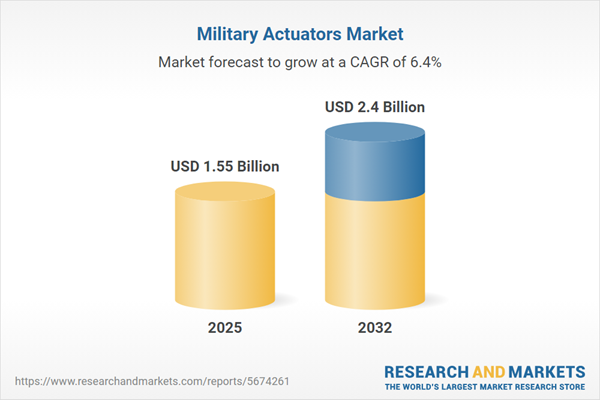Speak directly to the analyst to clarify any post sales queries you may have.
Senior leaders recognize that military actuators are now foundational to modern defense platforms, driving new standards in performance reliability and operational agility. To maintain a strategic advantage, organizations must stay aligned with rapid innovation while prioritizing system durability and mission readiness.
Market Snapshot: Military Actuators Market Size and Growth
The military actuators market continues to expand as global defense organizations modernize and digitize their forces. In 2024, the market is valued at USD 1.46 billion, set for steady growth with projections of USD 1.55 billion by 2025 and USD 2.40 billion by 2032, at a CAGR of 6.37%. Growth is fueled by increased adoption of digital and dependable actuation systems in defense missions worldwide, supporting the evolving needs of suppliers, integrators, and military end-users. This reflects heightened demand for resilient technology solutions and system upgrades to address mission complexity across different regions and applications.
Scope & Segmentation of the Military Actuators Market
- Actuator Types: Electric actuators provide efficient, precise control for contemporary platforms; hydraulic types support applications needing high-force movement; pneumatic actuators enable rapid response where timing is critical, such as in aerospace and armored vehicle subsystems.
- Solution Offerings: OEM actuators are integrated within newly built defense assets, while aftermarket solutions focus on extending platform life and optimizing existing systems with upgrades that enhance mission capability.
- Drive Mechanisms: Linear actuators power subsystems in vehicles and aircraft; rotary actuators supply adaptable solutions for both automated and manually operated equipment in military operations.
- Power Variants: Systems compatible with single-phase and three-phase input accommodate the varying energy requirements seen across global defense infrastructure, supporting flexible deployment.
- Applied Segments: Deployment spans fixed-wing and rotary aircraft, ground vehicles, naval ships, weaponry, and unmanned systems. Each demands engineering focused on reliability, tailored performance, and integration with existing command networks.
- Regional Breakdown: Demand varies between the Americas, EMEA, and Asia-Pacific. Purchase strategies reflect defense budget allocations, local regulatory frameworks, and readiness for adopting advanced actuator technologies.
- Key Industry Players: Companies leading technological innovation and system integration include Moog Inc., Eaton Corporation plc, Honeywell International Inc., Parker Hannifin Corporation, Curtiss-Wright Corporation, Thales Group, Safran S.A., and Woodward Inc.
Key Takeaways for Senior Decision-Makers
- Digital controls and advanced sensors incorporated within actuator systems now facilitate enhanced monitoring, enabling rapid operational adjustments and supporting high mission readiness.
- Strong collaboration among top contractors and specialized technology providers results in solutions designed to operate in complex defense settings and meet specific mission requirements.
- Standardizing actuator platforms and deploying additive manufacturing methods allows for faster technology upgrades, in line with shifting defense priorities and evolving mission demands.
- Comprehensive lifecycle support practices bolster system availability and readiness, offering resilience as the tempo of operations varies.
- Engineered durability enables actuators to perform reliably in harsh environments, reducing both downtime and long-term maintenance needs across deployments.
Tariff Impact: Navigating Supply Chain and Cost Pressures
With new U.S. tariffs impacting actuator parts and input materials, defense manufacturers are reviewing procurement and sourcing approaches. Building diverse supplier bases and using agile sourcing models help mitigate reliance on single suppliers, supporting price stability and consistent delivery schedules. This adaptability is increasingly critical as regulatory requirements affect supply continuity and cost structures.
Methodology & Data Sources
Research draws on feedback from senior defense executives, system integrators, and production experts within the industry. Comprehensive insights are developed through analysis of official government resources, patent reviews, and third-party validation, ensuring up-to-date and actionable information specific to the military actuators sector.
Why This Report Matters for Military Actuators
- Presents actionable insight into technological advances, evolving procurement strategies, and shifting operational risks impacting global military actuator adoption.
- Supports responsive strategic planning and process benchmarking as defense agencies navigate changing regulatory and capability requirements worldwide.
- Offers guidance for integrating new actuator solutions that align modernization initiatives with achievable operational goals for military organizations.
Conclusion
Advances in actuator design and a focus on robust supply chain management remain central to fulfilling evolving defense objectives. Rapid adoption of innovative actuators sets the stage for sustained mission capability and organizational agility in future defense environments.
Additional Product Information:
- Purchase of this report includes 1 year online access with quarterly updates.
- This report can be updated on request. Please contact our Customer Experience team using the Ask a Question widget on our website.
Table of Contents
3. Executive Summary
4. Market Overview
7. Cumulative Impact of Artificial Intelligence 2025
Companies Mentioned
The companies profiled in this Military Actuators market report include:- Moog Inc.
- Parker Hannifin Corporation
- Honeywell International Inc.
- Eaton Corporation plc
- Curtiss-Wright Corporation
- Thales Group
- Safran S.A.
- Woodward, Inc.
- AMETEK, Inc.
- Arkwin Industries, Inc.
- Beaver Aerospace & Defense, Inc.
- Creative Motion Control
- Elektro-Metall Export GmbH
- Kyntronics
- Meggitt PLC
- Raytheon Technologies Corporation
- Sierramotion by Allied Motion Technologies
- Triumph Group, Inc.
- Ultra Motion
- Venture Mfg. Co.
Table Information
| Report Attribute | Details |
|---|---|
| No. of Pages | 181 |
| Published | October 2025 |
| Forecast Period | 2025 - 2032 |
| Estimated Market Value ( USD | $ 1.55 Billion |
| Forecasted Market Value ( USD | $ 2.4 Billion |
| Compound Annual Growth Rate | 6.3% |
| Regions Covered | Global |
| No. of Companies Mentioned | 21 |









